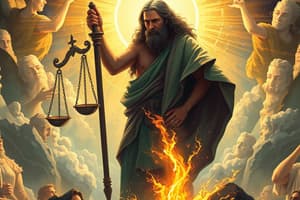Podcast
Questions and Answers
In Canto 7, what does Plutus' exclamation "O Satan! Satan!" primarily signify?
In Canto 7, what does Plutus' exclamation "O Satan! Satan!" primarily signify?
- A declaration of Plutus' allegiance to Satan as the supreme ruler of Hell.
- An expression of triumph over those who were poor in life.
- A call for Satan to intervene and offer salvation to the damned.
- Reflects the powerlessness of wealth when facing divine retribution. (correct)
What is the symbolic role of the "kind sage" (Virgil) in Canto 7?
What is the symbolic role of the "kind sage" (Virgil) in Canto 7?
- To challenge the authority of divine justice within the circles of Hell.
- To lead Dante into temptation to test his faith and resolve.
- To offer wealth and power as a means of escaping Hell's torments.
- To serve as a moral compass and provide clarity amidst despair. (correct)
How does Canto 7 depict the nature of divine justice?
How does Canto 7 depict the nature of divine justice?
- As impartial and inevitable, unaffected by earthly influence. (correct)
- As alterable, dependent upon the whims of those in power.
- As negotiable, where worldly power and wealth can influence outcomes.
- As arbitrary, with punishments assigned without regard to sin.
What does the metaphor comparing the fall of the fiend to a collapsing sailboat symbolize in Canto 7?
What does the metaphor comparing the fall of the fiend to a collapsing sailboat symbolize in Canto 7?
In Canto 7, what is the symbolic significance of the "dismal shore" in the fourth circle of Hell?
In Canto 7, what is the symbolic significance of the "dismal shore" in the fourth circle of Hell?
What does the conflict between the avaricious and the prodigal in Canto 7 symbolize?
What does the conflict between the avaricious and the prodigal in Canto 7 symbolize?
What does Dante's conversation about Fortune reveal?
What does Dante's conversation about Fortune reveal?
How does the concept of "Fortune" relate to divine justice?
How does the concept of "Fortune" relate to divine justice?
According to the guide, what is the relationship between the Church and corrupt souls?
According to the guide, what is the relationship between the Church and corrupt souls?
What does the Stygian lake symbolize?
What does the Stygian lake symbolize?
According to Canto 8, what do the two lights seen by Dante and his guide symbolize?
According to Canto 8, what do the two lights seen by Dante and his guide symbolize?
What does the figure of Phlegyas represent in Canto 8?
What does the figure of Phlegyas represent in Canto 8?
In Canto 8, what do pride and arrogrance result in?
In Canto 8, what do pride and arrogrance result in?
What role does Virgil play in guiding Dante through Hell?
What role does Virgil play in guiding Dante through Hell?
What does the punishment of Filippo Argenti illustrate about divine justice?
What does the punishment of Filippo Argenti illustrate about divine justice?
What does the city of Dis represent?
What does the city of Dis represent?
What does the red light from the city of Dis suggest?
What does the red light from the city of Dis suggest?
How does Dante react to the threatening words from the fallen angels?
How does Dante react to the threatening words from the fallen angels?
What is the significance of Virgil's words, 'I will not leave thee in this lower world'?
What is the significance of Virgil's words, 'I will not leave thee in this lower world'?
In Canto 9, what does 'High Authority permitted' represent?
In Canto 9, what does 'High Authority permitted' represent?
Flashcards
Plutus' exclamation Significance
Plutus' exclamation Significance
God of wealth, exclaiming in distress, reflecting wealth's powerlessness against divine justice and consequences of sins.
Role of the Kind Sage (Virgil)
Role of the Kind Sage (Virgil)
Symbolizes wisdom and guidance. He reassures and offers insight into divine justice, aiding Dante's journey.
Divine Justice Theme
Divine Justice Theme
Depicted as impartial and inevitable, with suffering souls in Hell due to their sins.
Metaphor of the Fiend's Fall
Metaphor of the Fiend's Fall
Signup and view all the flashcards
Description of the 4th circle of Hell
Description of the 4th circle of Hell
Signup and view all the flashcards
Symbolism of conflict
Symbolism of conflict
Signup and view all the flashcards
Dante's View on Fortune
Dante's View on Fortune
Signup and view all the flashcards
Concept of Fortune & Divine Justice
Concept of Fortune & Divine Justice
Signup and view all the flashcards
Church & Corrupt Souls in Hell
Church & Corrupt Souls in Hell
Signup and view all the flashcards
Significance of the Stygian Lake
Significance of the Stygian Lake
Signup and view all the flashcards
Narrator's Fear
Narrator's Fear
Signup and view all the flashcards
Erictho's mention
Erictho's mention
Signup and view all the flashcards
Symbolism of the furies
Symbolism of the furies
Signup and view all the flashcards
Danger of looking at Medusa
Danger of looking at Medusa
Signup and view all the flashcards
Significance of the wind
Significance of the wind
Signup and view all the flashcards
Figure's rhetorical questions
Figure's rhetorical questions
Signup and view all the flashcards
Flaming tombs and lamenting souls
Flaming tombs and lamenting souls
Signup and view all the flashcards
Meaning of the environment
Meaning of the environment
Signup and view all the flashcards
The concept of 'like with like'
The concept of 'like with like'
Signup and view all the flashcards
Study Notes
Canto 7: Significance of Plutus' Exclamation
- Plutus, the god of wealth, expresses fear and distress
- This highlights the impotence of wealth against divine justice
- Material wealth is unable to protect individuals from the repercussions of sin in the afterlife
Canto 7: Role of Virgil
- Virgil reassures Dante, offering comfort
- Virgil explains Plutus's inability to hinder Dante's descent
- Virgil embodies wisdom, calm, and guidance, shedding light on divine justice
Canto 7: Theme of Divine Justice
- Divine justice is impartial and inevitable
- Suffering in Hell stems from sins
- No force can alter divine retribution
- Worldly wealth and power pale against divine order
Canto 7: Metaphor for the Fiend's Fall
- The fiend's fall is likened to a collapsing sailboat, symbolizing sudden loss of power and control
- This portrays the fiend's vulnerability to divine justice and his inevitable downfall
Canto 7: Description and Symbolism of the Fourth Circle
- The fourth circle is depicted as a site where all the universe's woe is concentrated
- It signifies intense sorrow and suffering
- The "dismal shore" marks a boundary between Hell's realms
- It represents a transition to more severe punishments
Canto 7: Symbolism of the Avaricious and Prodigal Conflict
- Conflict symbolizes the eternal struggle between the avaricious and the prodigal
- Rolling weights symbolize the burdens and consequences of their actions
- The repeated question highlights the futility and endlessness of their struggle
- It underscores the consequences of greed and mismanagement of wealth
Canto 7: Revelation About Fortune
- Dante explores Fortune as an uncontrollable force shaping the rise and fall of individuals and nations
- Fortune serves as a divine mechanism that human wisdom cannot thwart
- Human lives are subject to forces beyond their control
Canto 7: Fortune and Divine Justice
- Fortune operates under divine guidance, serving a higher purpose in the divine order
- Fortune's actions contribute to the distribution of power and wealth
- Fortune serves as a form of divine justice
Canto 7: Relationship Between the Church and Corrupt Souls
- Virgil explains that souls with shorn heads misused wealth and power for personal gain when alive
- These souls once may have been monks or clergy
- The mention of popes and cardinals is a critique of the Church's greed and corruption
- The Church is portrayed as succumbing to avarice and corruption, despite its spiritual leadership role
Canto 7: Significance of the Stygian Lake
- The Stygian lake represents the depth of sin and despair, particularly anger
- Souls trapped in the lake are locked in a cycle of violence from unchecked rage
- Their eternal suffering highlights the consequences of giving in to such emotions
- The gurgling sounds mirror the internal chaos of the souls, revealing their inability to express themselves clearly
Canto 8: Significance of the Lights Seen
- Two lights, one near and one distant, symbolize communication between souls
- Light represents Dante's journey through Hell
- Divine or internal forces may guide or challenge his path
- Lights obscured by fog symbolize uncertainty, emphasizing the need for wisdom
Canto 8: Representation of Phlegyas
- Phlegyas embodies anger and revenge
- His bitterness embodies wrath and the eternal suffering of those overcome by anger
- His emotional intensity and refusal to accept his fate highlights the destructive power of unchecked rage
Canto 8: Themes of Sin and Judgment
- Encounter with the soul covered in filth signifies the consequences of pride and arrogance
- The soul transforms into a vile creature reflecting how sin distorts the soul
- Dante's recognition and Virgil's subsequent rejection demonstrate divine justice and the consequences of moral corruption
Canto 8: Virgil's Role
- Virgil is a wise and composed figure guiding Dante
- He provides explanations, comfort, and protection
- Virgil's authority and calmness contrast with the souls' suffering
- Virgil reinforces the rational guide role through a world of chaos
Canto 8: Florentine Filippo Argenti and Divine Justice
- Filippo Argenti’s punishment illustrates the retribution of divine justice
- His arrogance and pride in life are now met with similar aggression.
Canto 8: Significance of Dis
- Dis is named the final/lowest part of hell, housing the worst sinners
- Dis is the location of torment for those who committed grave sins (heresy, violence, betrayal)
- It marks the beginning of Dante's most intense trials
Canto 8: Symbolic of the Red Light
- Red light symbolizes the eternal fire of hell, while vermillion suggests eternal damnation
- The imagery evokes divine wrath and the soul's irreversible damnation
Canto 8: Dante's Reaction
- Dante reacts with fear and doubt to the fallen angels guarding Dis
- Panic and desperation contrasts with Virgil's calm demeanor, indicating Dante's vulnerability and dependence on Virgil
Canto 8: Significance of Virgil's Words
- Virgil's assurance that he will not abandon Dante reflects their strong, protective bond
- Virgil, symbolizing reason and wisdom, emphasizes the importance of faith and trust in guidance amidst obstacles
Canto 8: Concepts of Authority
- High authority suggests that Dante's path through hell is governed by divine will
- Events in the afterlife are part of God's plan, beyond challenge
- Divine Justice preordains and guides his journey
Canto 9: Narrator's Contrast
- Dante's fear and anxiety contrast his guide's deeper understanding and control
Canto 9: Erictho Significance
- Guide reminds Dante of Erictho's dark sorcery and that those who inhabit hell have power
- The Guide highlights the deep despair and corruption Dante will encounter
Canto 9: Symbolism of the Furies
- Megaera, Alecto, and Tisiphone represent vengeance, torment, and furies of punishment
- Violent imagery intensifies the danger and suffering
Canto 9: Dante's Warning
- Dante is warned not to look at Medusa, suggesting Medusa's gaze symbolizes the danger of being overwhelmed by fear or sin that moral corruption can result in being paralyzed
Canto 9: Significance of Wind/Spirits
- Chaotic elements reinforce the restless nature of Hell, with unrelenting torment
- Souls in constant torment are unable to escape suffering
Canto 9: Mysterious Figure's Impact
- A divine force enables Dante's passage, suggesting divine will governs heavens and hell
Canto 9: Outcasts Rhetorical
- Damned souls are rebuked for arrogance in their defiance of the divine will that has led to their unending torment
Canto 9: Flamming Tombs
- Flaming tomb imagery symbolizes intense suffering of arch-heretics
- Flames represent spiritual and physical agony after rejecting divine truth
Canto 9: Environment Reinforcement
- The dark fog, gate, and tombs, reinforce Hell's nature as a place of confusion and separation
Canto 9: Concept of Like
- Punishments that correspond to beliefs and actions on earth
- Divine justice meted out reflects the moral order within Hell
Studying That Suits You
Use AI to generate personalized quizzes and flashcards to suit your learning preferences.




